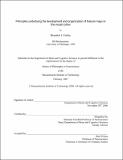Principles underlying the development and organization of feature maps in the visual cortex
Author(s)
Farley, Brandon J. (Brandon James)
DownloadFull printable version (3.057Mb)
Other Contributors
Massachusetts Institute of Technology. Dept. of Brain and Cognitive Sciences.
Advisor
Mriganka Sur.
Terms of use
Metadata
Show full item recordAbstract
A fundamental question in neuroscience is how sensory information is represented in the brain. In particular, what principles guide the spatial organization of neurons with regard to their receptive field properties, and how is this organization established mechanistically? The visual cortex serves as a model area to address these questions, but whether general principles can explain the layouts of cortical maps, such as those of visual space and of specific response features, remains unresolved. We find that in primary visual cortex of ferret, the layout of each map is inter-dependent with that of the others. First, we find a strong anisotropy in the visual map, such that receptive field positions change more rapidly along one axis of cortex; and importantly, along the axis where visual space changes rapidly, the feature maps of orientation, ocular dominance, and spatial frequency change slowly. Second, orientation, ocular dominance, and spatial frequency maps have local spatial relationships with each other: in areas of cortex where one feature changes rapidly, the other features change more slowly. Each of these relationships are well-explained by a dimension-reduction model of cortex. (cont.) This suggests that the constraints which drive map formation in the model, continuity (representing each feature smoothly across cortex) and coverage uniformity (representing each feature combination to an equal extent), may play a central role in determining the functional organization of visual cortex. To explore the mechanisms giving rise to the map relationships, we alter the expression of one feature map early in development and measure the impact on the layouts of the remaining maps. We find that alteration of the ocular dominance map, due to neonatal monocular enucleation, does not prevent the formation of the orientation and spatial frequency maps, but it does alter their spatial relationships. The highest gradient regions of the spatial frequency map have a stronger tendency to avoid high gradient orientation regions, and the contours of the two maps have a greater tendency to cross orthogonally. The results are consistent with the predictions of a dimension-reduction model for removing a feature map, suggesting that as a result of altered input patterns, the cortex can rearrange over the time scale of development according to a dimension-reduction strategy.
Description
Thesis (Ph. D.)--Massachusetts Institute of Technology, Dept. of Brain and Cognitive Sciences, February 2007. This electronic version was submitted by the student author. The certified thesis is available in the Institute Archives and Special Collections. Includes bibliographical references (leaves 139-142).
Date issued
2007Department
Massachusetts Institute of Technology. Department of Brain and Cognitive SciencesPublisher
Massachusetts Institute of Technology
Keywords
Brain and Cognitive Sciences.